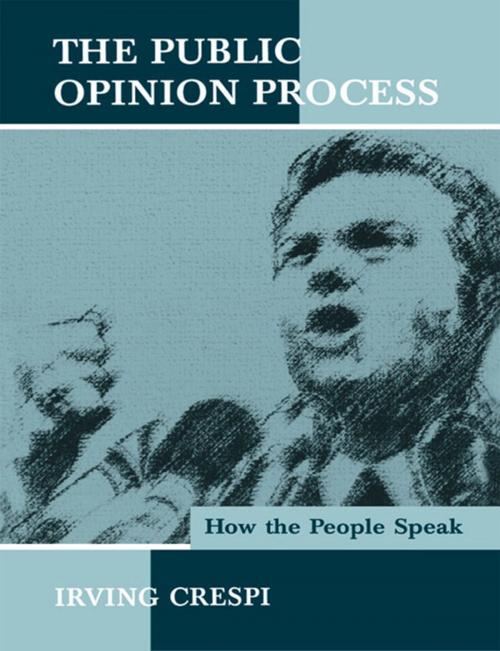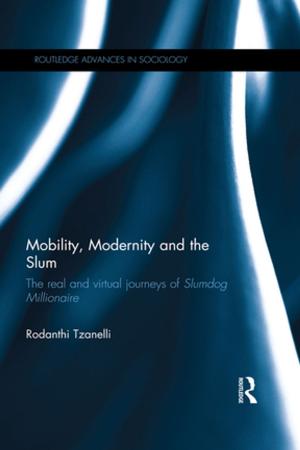The Public Opinion Process
How the People Speak
Nonfiction, Reference & Language, Language Arts, Journalism| Author: | Irving Crespi | ISBN: | 9781136684883 |
| Publisher: | Taylor and Francis | Publication: | November 5, 2013 |
| Imprint: | Routledge | Language: | English |
| Author: | Irving Crespi |
| ISBN: | 9781136684883 |
| Publisher: | Taylor and Francis |
| Publication: | November 5, 2013 |
| Imprint: | Routledge |
| Language: | English |
What is public opinion? How can we best study it?
This work presents a "process model" that answers these questions by defining public opinion in a way that also identifies an approach to studying it. The model serves as a framework into which the findings of empirical research are integrated, producing a comprehensive understanding of public opinion that encompasses the congeries of middle-range theories that have emerged from empirical research. The three-dimensional process model--and the way it is explicated--satisfies the diverse and sometimes divergent needs and interests of political scientists, sociologists, social psychologists, and communication specialists who study public opinion. This is achieved by clearly differentiating and interrelating the following:
* individual opinions--the judgmental outcomes of a process in which attitudinal systems--comprised of beliefs, values/interests, and feelings--function as intervening variables that direct and structure perceptions of public issues;
* collective opinions--the outcomes of communication from which mutual awareness emerges and that integrate separate individual opinions into a significant social force; and
* political roles of collective and individual opinions--the outcomes of the extent to which collective and individual opinions have achieved legitimacy as the basis for governing a people.
DON'T USE THIS PARAGRAPH FOR GENERAL CATALOGS... Each dimension of the model has its corresponding subprocess: transactions between individuals and their environments, communications among individuals and collectives, and political legitimation of public opinion. Since the process model is -- by definition -- interactional, none of the three dimensions has theoretical or sequential priority over the others. Instead of treating the psychological, political, and sociological aspects of public opinion as separate stages of an unidirectional process, the three aspects are modeled as dimensions of a complex, ongoing system in continuous interaction with each other. This conceptualization satisfies the need for a truly interdisciplinary theory in that it demands that each dimension be studied in terms of its defining sub-process. It also avoids the twin errors of reductionism and reification in the study of public opinion.
What is public opinion? How can we best study it?
This work presents a "process model" that answers these questions by defining public opinion in a way that also identifies an approach to studying it. The model serves as a framework into which the findings of empirical research are integrated, producing a comprehensive understanding of public opinion that encompasses the congeries of middle-range theories that have emerged from empirical research. The three-dimensional process model--and the way it is explicated--satisfies the diverse and sometimes divergent needs and interests of political scientists, sociologists, social psychologists, and communication specialists who study public opinion. This is achieved by clearly differentiating and interrelating the following:
* individual opinions--the judgmental outcomes of a process in which attitudinal systems--comprised of beliefs, values/interests, and feelings--function as intervening variables that direct and structure perceptions of public issues;
* collective opinions--the outcomes of communication from which mutual awareness emerges and that integrate separate individual opinions into a significant social force; and
* political roles of collective and individual opinions--the outcomes of the extent to which collective and individual opinions have achieved legitimacy as the basis for governing a people.
DON'T USE THIS PARAGRAPH FOR GENERAL CATALOGS... Each dimension of the model has its corresponding subprocess: transactions between individuals and their environments, communications among individuals and collectives, and political legitimation of public opinion. Since the process model is -- by definition -- interactional, none of the three dimensions has theoretical or sequential priority over the others. Instead of treating the psychological, political, and sociological aspects of public opinion as separate stages of an unidirectional process, the three aspects are modeled as dimensions of a complex, ongoing system in continuous interaction with each other. This conceptualization satisfies the need for a truly interdisciplinary theory in that it demands that each dimension be studied in terms of its defining sub-process. It also avoids the twin errors of reductionism and reification in the study of public opinion.















